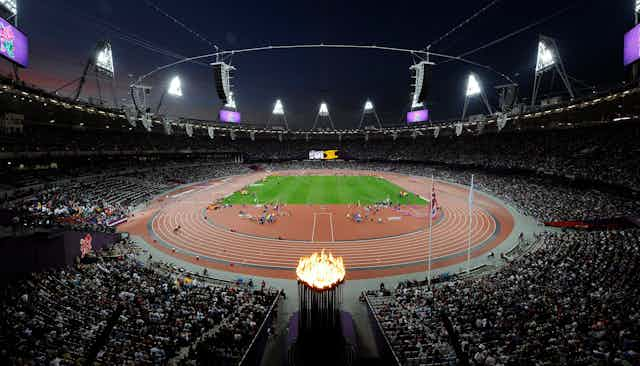It was painful to see the Olympic rings taken down from London Bridge after the Olympics only to be replaced by the Paralympics emblem (the three agitos).
Aside from the fact this emblem was not chosen by a consensus of athletes self-identified as “disabled” or differently abled, it is a mark of separation that insults the humanistic ethos of the Olympics.
In short: all Olympic athletes should compete together in one Olympic Games.
This realisation came to me during a recent conversation with my father-in-law. He asked why differently abled people were made to be so separate from other athletes. As I began investigating this important question, I realised this separation is possibly the last discriminatory hurdle for the Olympics to clear.
Some might argue that a separate games for “disabled” people highlights their personal needs – but this form of attention can be generated better when it is sewn into the fabric of what many individuals consider to be “the main event”.
Only one woman is known to have competed during the ancient (Greek) Olympics, at least based on the patchwork evidence still available to us. Her name was Belistiche and she competed some 2,276 years ago as a chariot racer, winning an event.
The ancient Games were, for the most part, only for free Greek-speaking men – probably only those that met standard citizenship requirements for the different polities in the region (i.e. those city-states or oligarchic republics that sent participants to compete for imperial glory).
In the “modern” Olympics men and women, big and tall, short and lean have all competed. Such athletes are, for the most part, individuals self-identifying as having no major physical, emotional or mental disadvantages. But now, thankfully, this is not always the case.
Oscar Pistorius, a double below-the-knee amputee known as “the blade runner”, is a primary and wonderful example. He competed in the 400m dash and the 4x400m relay at the London Olympics, although in the latter he was not able to run due to a teammate falling down on the track. Pistorius is one of the first amputees ever to compete in the Olympic Games. (The first was George Eyser who competed in gymnastics in 1904 with a wooden leg).
The point here is simple: people who are said to have a disability, or who say they have a disability, are actual human beings and should be treated with the same collegiality as more able (is anyone ever fully able?) men and women.
This includes people that define their own gender – although that important topic needs its own separate discussion from this one. That is why I think the Paralympics should be dissolved and that all Olympians should compete in one singular, human, Olympics.
That way we can have women and men (and intersex and transgendered individuals) with different abilities, compete in their own trials and, where possible, together. If the attractively named “blade-runners” are able to compete with “non-blade runners” – as with Pistorius in the London Olympics – then why not have relays with people in wheelchairs? Or include blind runners and their running-mates in marathons or other longer-distance competitions?
Combining all Olympians is a necessary statement for the Games to make as this guarantees certain minimal equal treatment for every individual. Naturally, consensus between athletes, coaches, federations and so forth on greater equality between competitors before, during, or after the Games is also needed.
Adding athletes that are now labelled as “Paralympians” into the Olympics would probably require an additional week or two of competition. This may provide greater cultural and economic returns to the host than are currently possible. After all, why invest all of that public money for two short weeks? I think it would be better to integrate all events and stretch the event out.
The pathos, or emotion, for a move to a unified Olympics was expressed in the opening ceremony to the Paralympic Games. Therein we saw powerful themes including:
- the Universal Declaration of Human Rights
- the freeing effects of scientific discovery and the beautiful hope it gives to all humans
- the giant sculpture of Alison Lapper who was the subject that inspired such great art
- the United Conventions on the Rights of Disabled Persons.
These are calls for persons that are differently abled to be treated as actual equal human beings. The emotion and logic behind this emancipation is no different to the historic and ongoing struggles of women, indigenous peoples, minorities, LGBTI, “black” or darker-toned individuals, young adults or teenagers, and the elderly.
It took more than 2,000 years for people other than adult men to compete in the Olympics. Even children today are competing against adult men and women – see, for instance, impressive young talents such as Togolese swimmer Adzo Kpossi (13 years old), Malawian swimmer Joyce Tafatatha (14 years old) and US swimmer Kathleen Ledecky (15 years old).
We are now on the cusp of a great victory for human emancipation. It has been staring us in the face in the past but the London Paralympics has brought the issue to the fore.
Let us compete together as one collective humanity. There is no such thing as a disabled person. There are only people with different abilities.

